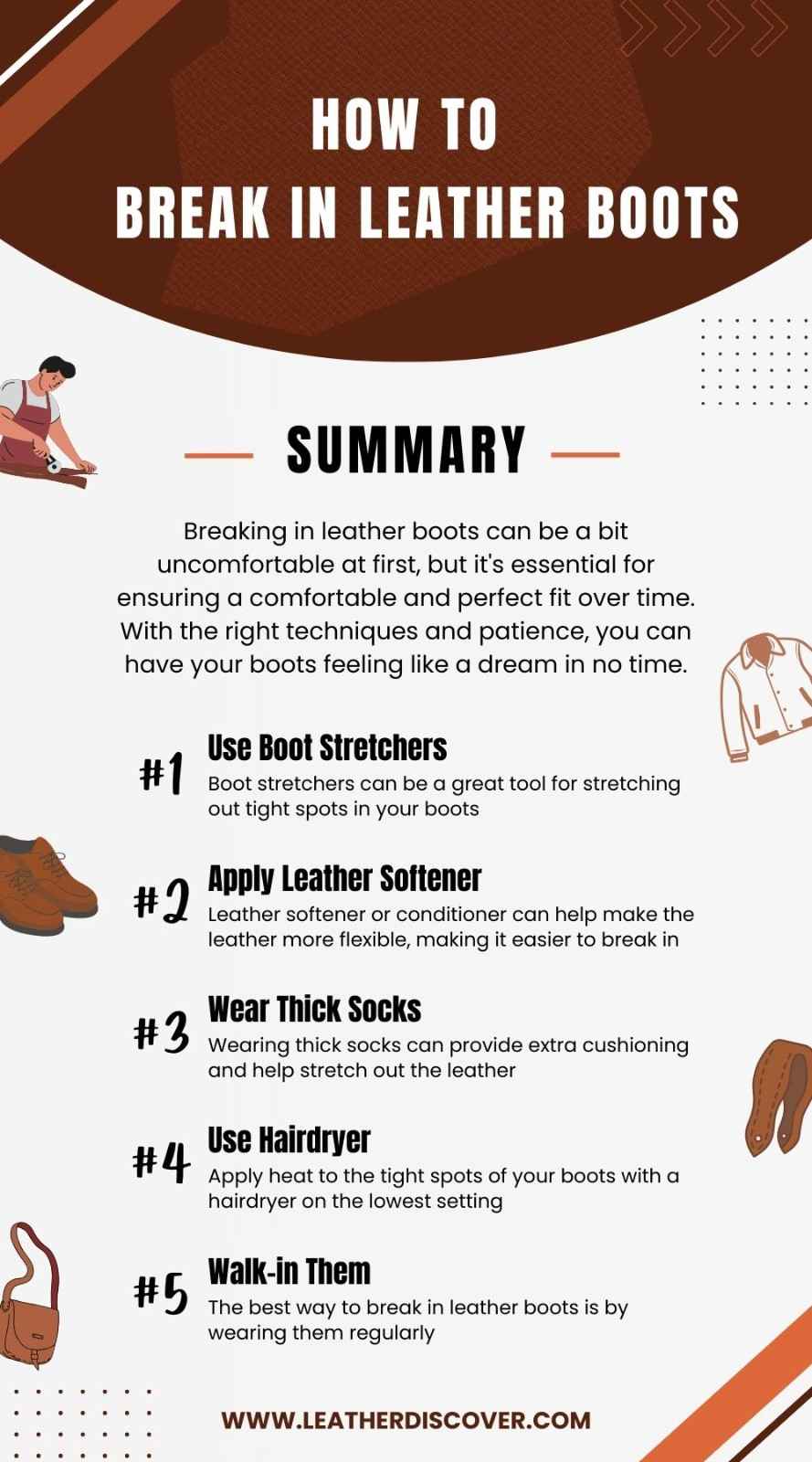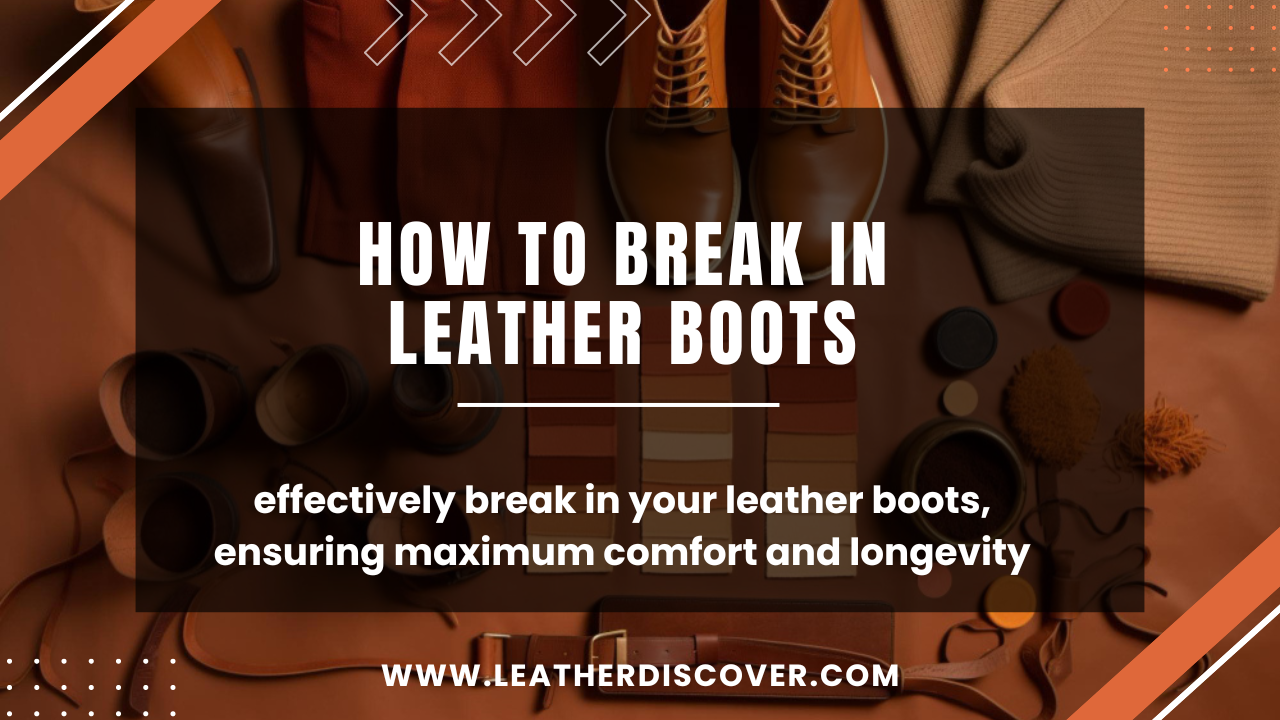There is something about a pair of leather boots that can make you feel like you can conquer the world.
Leather boots are not just a fashion statement; they symbolize durability, craftsmanship, and timeless style.
But before truly enjoying them, you have to break them in.
We all know the struggles of dealing with stiff, uncomfortable boots that rub and blister your feet. But fear not, breaking into leather boots doesn’t have to be a painful process.
With the right techniques and patience, you can have your boots feeling like a dream in no time.
In this guide, we’ll walk you through the steps to effectively break in your leather boots, ensuring maximum comfort and longevity.

How to Break in Leather Boots?
Breaking in leather boots can be a bit uncomfortable at first, but it’s essential for ensuring a comfortable and perfect fit over time.
Here are some tips on how to break in leather boots effectively:
- Wear Them Around the House: Start by wearing your new leather boots around the house for short periods. This will help the leather mold to the shape of your feet without causing excessive discomfort.
- Use Boot Stretchers: Boot stretchers can be a great tool for stretching out tight spots in your boots. Insert them into your boots overnight to help widen specific areas like the toe box or the width of the boot.
- Apply a Leather Softener: Leather softener or conditioner can help make the leather more flexible, making it easier to break in. Apply the conditioner to the inside and outside of the boots and let them sit for a few hours before wearing them.
- Wear Thick Socks: Wearing thick socks can provide extra cushioning and help stretch out the leather more quickly. It can also prevent blisters and soothe any discomfort caused by stiff leather rubbing against your skin.
- Use a Hairdryer: Apply heat to the tight spots of your boots with a hairdryer on the lowest setting. The heat will help soften the leather, making it more flexible and easier to stretch.
- Walk-in Them: The best way to break in leather boots is by wearing them regularly. Take short walks in your boots to help loose the leather and allow your feet to adjust to the new fit.
- Use a Boot Stretcher Spray: Boot stretcher sprays are designed to soften the leather and make it more pliable, allowing you to stretch out tight spots more easily. Follow the instructions on the spray bottle for the best results.
Remember, breaking in leather boots takes time, so be patient and consistent. With the right techniques and perseverance, you’ll soon have a comfortable and well-fitting pair of boots perfect for your feet.
Source: Trenton & Health YT Channel
Do’s and Don’ts of Breaking in Leather Shoes
The following table highlights the Do’s and Don’ts of breaking into leather boots.
Certainly! Here’s a table outlining the Do’s and Don’ts when breaking in leather boots:
| Do’s | Don’ts |
|---|---|
| Wear your boots around the house for short periods to gradually break them in. | Don’t wear your boots for long periods if they are causing discomfort or pain. |
| Use a high-quality leather conditioner to soften the leather and prevent cracking. | Don’t use harsh chemicals or cleaning products on your leather boots, as they can damage the leather. |
| Wear thick socks made from natural materials to cushion your feet and reduce friction. | Don’t wear thin socks or go sockless while breaking in your boots, as this can lead to blisters. |
| Take your boots for short walks, to further mold the leather to the shape of your feet. | Don’t expose your boots to extreme heat sources, as this can cause the leather to dry out and crack. |
| Target problem areas using a leather stretching spray or shoe stretcher to relieve pressure points. | Don’t ignore signs of discomfort or pain while breaking in your boots, as this can lead to long-term foot problems. |
| Be patient and allow plenty of time for your boots to soften and mold to your feet. | Don’t force your feet into boots that are too tight or uncomfortable, as this can cause injury. |
| Use heat, such as a hairdryer on a low setting, to help soften the leather if needed. | Don’t store your boots in damp or humid conditions, as this can cause mold and mildew to develop. |
Following these Do’s and Don’ts will help you break in your leather boots effectively while ensuring maximum comfort and longevity.
Should Leather Boots Be Tight At First?
Leather boots should not be uncomfortably tight at first, but they should fit snugly.
When you first try on a pair of leather boots, they may feel slightly tight, especially if made from high-quality, durable leather.
This is normal because leather naturally stretches and molds to the shape of your feet over time.
A snug fit is important because it allows your boots to provide proper support and stability while also preventing excessive rubbing and friction that can lead to blisters.
However, if your boots feel painfully tight or constricting, they are likely too small and may need to be exchanged for a larger size.
It’s essential to remember that leather boots will stretch and become more comfortable as you wear them, so a slightly snug fit at first is normal.
However, if you experience persistent discomfort or pain while wearing your leather boots, it’s essential to address the issue promptly to avoid foot problems in the future.
What Happens If You Wear Leather Boots That Are Too Small?
Wearing leather boots that are too small can lead to various issues and discomfort.
Some potential consequences include:
1. Foot Pain
Wearing small boots can put pressure on your toes, leading to pain and discomfort.
This can result in conditions like blisters, corns, or ingrown toenails.
2. Restricted Blood Flow
If the boots are too tight, they can restrict blood flow to your feet, causing numbness, tingling, and even a risk of developing blood clots in severe cases.
3. Foot Deformities
Continued use of small boots can lead to foot deformities over time, such as bunions or hammertoes, which may require medical intervention to correct.
4. Ingrown Toenails
Tight boots can cause the toenails to grow into the surrounding skin, leading to pain, inflammation, and potential infection.
5. Calluses and Corns
Constant friction and pressure from small boots can cause the formation of calluses and corns on your feet, which can be painful and unsightly.
6. Back and Knee Pain
Ill-fitting footwear can affect your posture and walking gait, leading to back, knee, or hip pain due to the improper distribution of weight and pressure on your feet.
Overall, wearing small leather boots is not recommended as it can lead to discomfort, pain, and potential long-term foot problems. It is important to wear properly fitting footwear to ensure the health and comfort of your feet.
Conclusion
Breaking in leather boots is a process that requires patience and care to achieve a comfortable and personalized fit.
Focusing on problem areas, using a shoe stretcher spray, and gradually increasing wear time are key strategies for breaking in leather boots effectively
Remember that each pair of leather boots is unique, so be attentive to your boots’ specific needs and adjust your breaking-in routine accordingly.
Take your time and listen to your feet – they’ll thank you for it in the end!
Resources Consulted
- Foot Fitter
- Leather Honey
- Kids Health
- What Is Caiman Leather? A Detailed Guide - July 25, 2024
- What Is Tumbled Leather?A Complete Guide - July 25, 2024
- What Is Kip Leather? Premium Leather Choice - July 24, 2024

